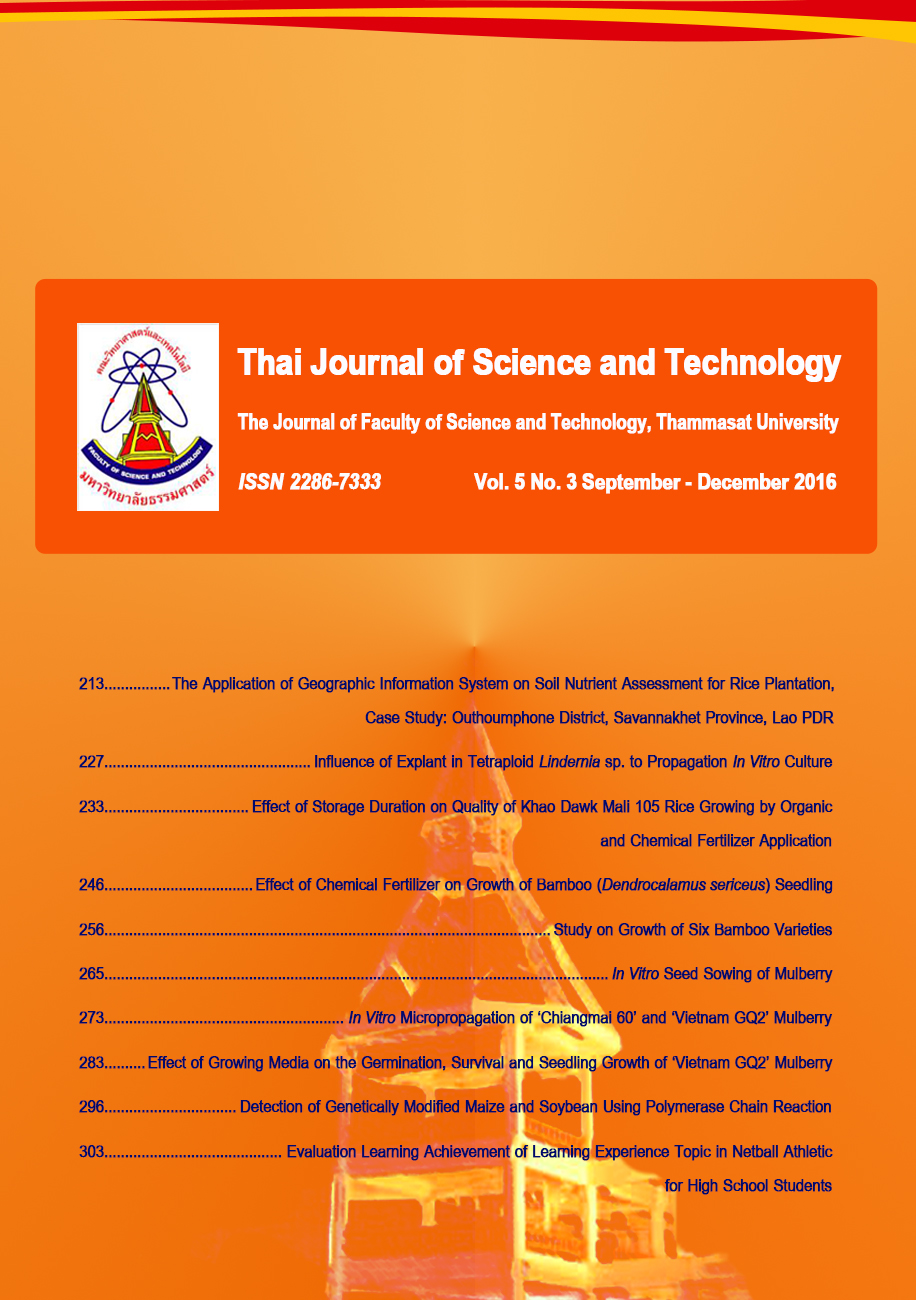การประยุกต์ระบบสารสนเทศภูมิศาสตร์เพื่อประเมินธาตุอาหารพืชในดินสำหรับการปลูกข้าว กรณีศึกษา : อำเภออุทุมพร จังหวัดสุวรรณเขต สปป ลาว
Main Article Content
Abstract
บทคัดย่อ
การวิจัยนี้มีวัตถุประสงค์เพื่อประเมินพื้นที่คุณภาพธาตุอาหารพืชที่มีอยู่ในดินของอำเภออุทุมพร จังหวัดสุวรรณเขต สปป ลาว โดยการประยุกต์ระบบสารสนเทศภูมิศาสตร์เพื่อวิเคราะห์ ประมวลผล และจัดทำแผนที่ตามพิกัดทางภูมิศาสตร์ของลักษณะพื้นที่และสมบัติสำคัญของดิน ที่จะใช้ในการเพิ่มผลผลิตข้าวให้ได้ตามแผนยุทธศาสตร์การพัฒนาที่ดินเพื่อการเกษตรของลาว โดยได้แบ่งการเก็บข้อมูลอำเภออุทุมพร ซึ่งมีพื้นที่ทั้งสิ้น 676,481.77 ไร่ ออกตามความลาดชันและประเภทเนื้อดิน (ดินเหนียว ดินทรายแป้ง และดินทราย) แล้วกระจายการเก็บตัวอย่างดินตามกระบวนการสำรวจดินพร้อมจุดพิกัดทั้งหมด 44 จุด นำดินที่สุ่มเก็บจากพื้นที่มาวิเคราะห์ธาตุอาหารพืชและสมบัติในห้องปฏิบัติการ 7 ปัจจัย คือ ปริมาณค่าความเป็นกรด-ด่างของดิน อินทรียวัตถุในดิน ไนโตรเจน ฟอสฟอรัส โพแทสเซียม ความจุในการแลกเปลี่ยนประจุบวกของดิน และความอิ่มตัวด้วยประจุบวกที่เป็นด่าง เพื่อใช้ประเมินศักยภาพพื้นที่ธาตุอาหารพืชในดิน จากนั้นได้สร้างแบบจำลองทางคณิตศาสตร์ด้วยระบบสารสนเทศภูมิศาสตร์ ซึ่งประกอบด้วยการสร้างแผนที่ของทั้ง 7 ปัจจัย ที่ทำการศึกษา พบว่าดินในอุทุมพรส่วนใหญ่เป็นดินทรายมีความเป็นกรดจัดถึงรุนแรงมากที่สุด ปริมาณไนโตรเจน ฟอสฟอรัส โพแทสเซียม ความอิ่มตัวด้วยประจุบวกที่เป็นด่างมีค่าต่ำถึงค่อนข้างต่ำ และอินทรียวัตถุในดินมีค่าต่ำถึงต่ำที่สุดกระจายอยู่ทั่วอำเภออุทุมพร ในขณะที่มีพื้นที่ปริมาณความจุในการแลกเปลี่ยนประจุบวกค่อนข้างสูงถึงสูงกระจายอยู่ทั่วไป ซึ่งจะเอื้อให้พืชตอบสนองต่อการปรับปรุงดินด้วยการเพิ่มธาตุอาหาร นอกจากการปรับปรุงสมบัติดิน โดยการปรับสภาพดินและเพิ่มธาตุอาหารพืชเพื่อเพิ่มผลผลิตข้าวแล้วนั้น อาจใช้วิธีจัดการอื่นเพื่อเพิ่มผลผลิตข้าวร่วมด้วย เช่น การเลือกพื้นที่ให้เหมาะสมกับชนิดพืช หรือมีการปรับปรุงพันธุ์ข้าวให้มีความทนทานต่อสภาพดินในพื้นที่
คำสำคัญ : ระบบสารสนเทศภูมิศาสตร์; การประเมินพื้นที่ธาตุอาหารพืชในดิน; การปลูกข้าว
Abstract
This research aims to assess soil nutrient and its significant conditions to increase rice production in Outhoumphone District, Savannakhet Province, Lao PDR. Geographic Information System (GIS) has been applied to process overall data base, analyze, and prepare maps with geographical coordinates for the effective national agricultural land use plan of Lao PDR. Land and soil characteristics of the district covered the area of 676,481.77 rai has been classified by the slope and soil texture (sand, silt, and clay) for field investigation and soil collection of 44 samples which represented each location. Soil samples were analyzed in laboratory by applying the standard soil survey and laboratory analytical methods for its macronutrient elements and properties, consisting of 7 factors which were the amount of nitrogen (N), phosphorus (P), potassium (K), soil acid-alkaline (pH), soil organic matter (OM), the cation exchange capacity of the soil (CEC) and base saturation (BS). Results of the study on soils and land were used in soil suitability assessment with an application of mathematical data base management model. Data base analytical results in GIS has been used to evaluate land potential by construction of maps. It was found that soil in the study area was mostly sand with strongly to very strong acidity together with the low to lowest amount of N, P, K, OM, and BS scattering around the district area. However, the data of high CEC level in the soil implied that land potential for rice plantation should be risen up with suitable soil nutrients management. Beside the adjustment of soil property and fertility treatment, the future practices could consider the suitable land utilization for proper crops or applying the selective varieties of rice for this district.
Keywords: geographic information system; soil nutrients assessment; rice plantationArticle Details
บทความที่ได้รับการตีพิมพ์เป็นลิขสิทธิ์ของคณะวิทยาศาสตร์และเทคโนโลยี มหาวิทยาลัยธรรมศาสตร์ ข้อความที่ปรากฏในแต่ละเรื่องของวารสารเล่มนี้เป็นเพียงความเห็นส่วนตัวของผู้เขียน ไม่มีความเกี่ยวข้องกับคณะวิทยาศาสตร์และเทคโนโลยี หรือคณาจารย์ท่านอื่นในมหาวิทยาลัยธรรมศาสตร์ ผู้เขียนต้องยืนยันว่าความรับผิดชอบต่อทุกข้อความที่นำเสนอไว้ในบทความของตน หากมีข้อผิดพลาดหรือความไม่ถูกต้องใด ๆ


